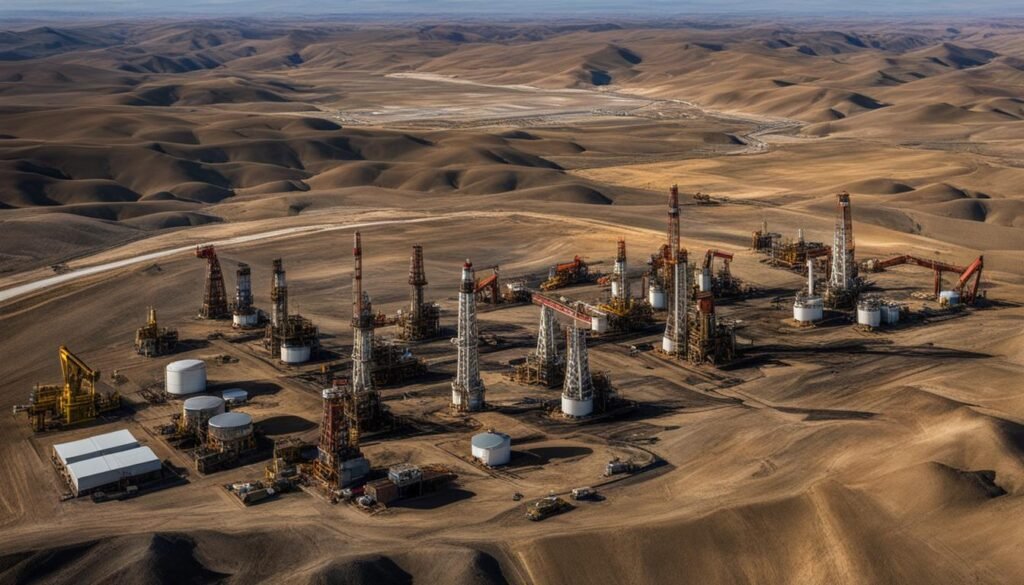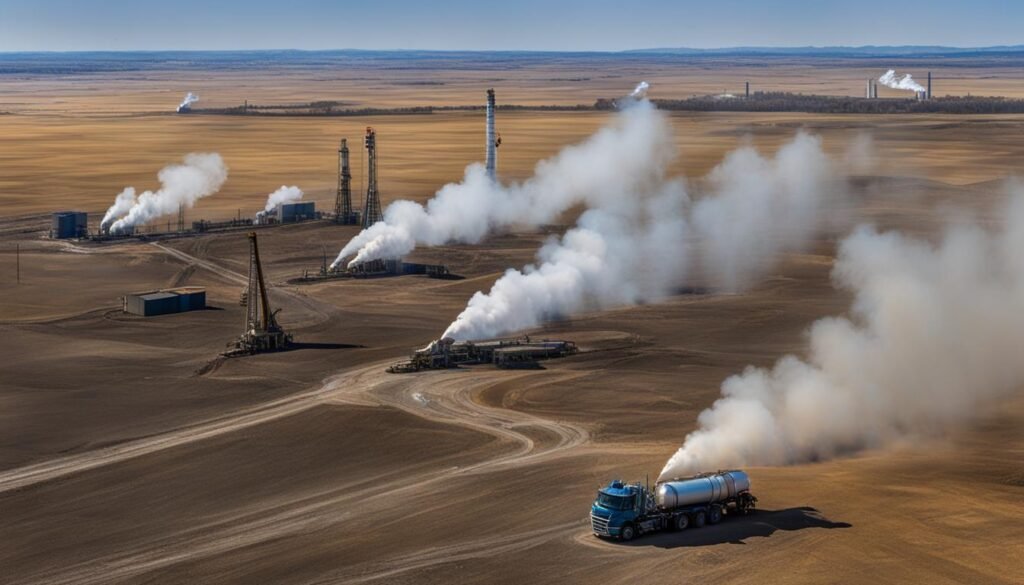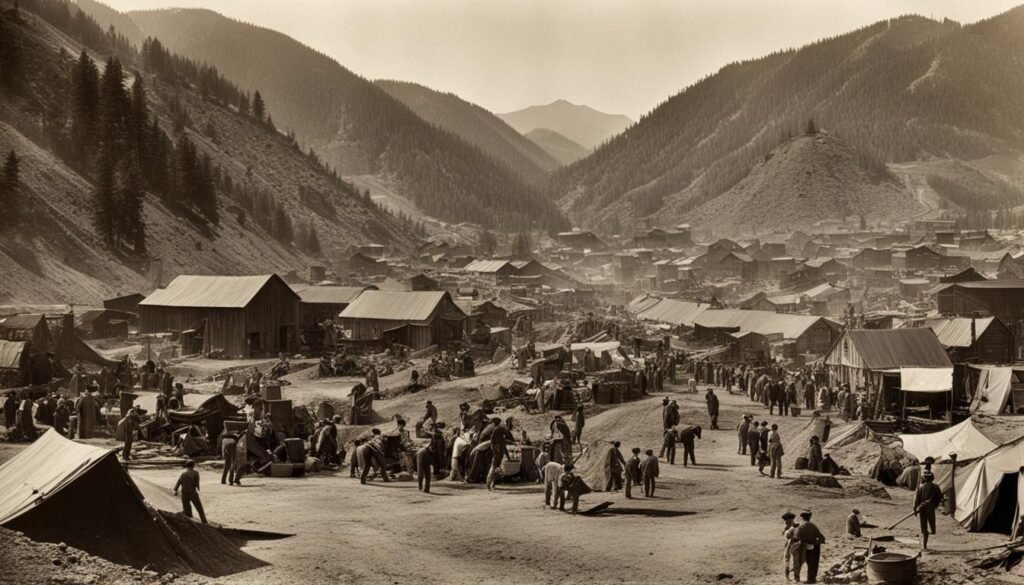California, known for its stunning coastline, vibrant cities, and diverse landscapes, is also home to a rich history of oil exploration and production. The state’s oil fields have played a significant role in shaping its economy and energy landscape. From the early days of drilling to the present, California has been at the forefront of the oil industry, making it an intriguing destination for those interested in the world of oil. In this article, I will take you on a journey through the oil fields in California, sharing fascinating facts and essential information about oil in the Golden State.
Key Takeaways:
- California has a long history of oil exploration and production.
- Oil drilling in California began in the late 19th century.
- Southern California became a prolific oil-producing region in the 1920s.
- The oil and gas industry has made a significant impact on California’s economy.
- The state aims to transition to cleaner and renewable energy sources while utilizing its oil resources responsibly.
The Impact of the Oil and Gas Industry in California
The oil and gas industry in California has had a profound effect on the state’s economy and environment. While it has faced its fair share of challenges, such as the Exxon oil spills in the Santa Barbara Channel in 1969 and 2015, the industry has also played a vital role in job creation and economic growth.
California has long been a leader in oil and gas production, with a diverse range of companies involved in exploration, drilling, and production. These activities have not only provided employment opportunities but have also contributed significantly to the state’s revenue and tax base.
However, it is essential to acknowledge the environmental consequences that have accompanied this industry. The Exxon oil spills, in particular, resulted in severe environmental damage to marine life and coastal ecosystems. These incidents have highlighted the need for stricter regulations and enhanced safety measures to prevent future oil spills and minimize the industry’s impact on California’s delicate ecological balance.
Despite these challenges, the oil and gas industry continues to be a significant contributor to California’s economy and energy infrastructure. It supplies the state with vital resources to meet its energy demands and supports various ancillary industries.
The image below highlights the Exxon oil spill in the Santa Barbara Channel, symbolizing the environmental impact of such incidents:

As California looks towards a future with cleaner and renewable energy sources, the oil and gas industry will inevitably undergo further changes. The state’s commitment to reducing greenhouse gas emissions and promoting renewable energy production will shape the industry’s path moving forward.
It is important that the California oil and gas industry aligns itself with these changing dynamics and becomes proactive in exploring sustainable solutions. This includes diversifying energy portfolios, investing in research and development of cleaner technologies, and actively participating in initiatives aimed at reducing the industry’s environmental footprint.
In conclusion, the oil and gas industry has left an indelible mark on California’s economy and environment. While it has faced significant challenges and environmental setbacks, it has also provided employment opportunities and contributed to the state’s overall growth. As California charts its course towards a greener future, it is crucial for the industry to adapt and play a responsible role in the state’s energy transition.
The Future of Energy Production in California
As the world moves towards cleaner and renewable energy sources, the future of energy production in California is undergoing a significant transformation. California, known for its ambitious environmental goals, has set targets to reduce greenhouse gas emissions and increase renewable energy production. This shift towards sustainability has led to changes in the oil and gas industry, with a renewed focus on reducing reliance on fossil fuels.
The California oil and gas commission plays a crucial role in regulating the industry and ensuring the responsible extraction of oil and gas resources. The commission works diligently to enforce environmental standards and promote sustainable practices among California oil producers. Their efforts are aimed at minimizing the environmental impact of oil and gas operations while supporting the state’s energy needs.
In addition to regulatory measures, California recognizes the importance of its oil reserves in maintaining a stable energy supply. The state’s proven oil reserves, located in various oil fields across the region, continue to be an important asset. California’s oil producers work tirelessly to extract these reserves safely and efficiently, contributing to the state’s energy demands while embracing the need for sustainable practices.
In conclusion, while California is actively transitioning towards cleaner energy sources, the oil and gas industry remains an integral part of the state’s energy portfolio. The collaboration between the California oil producers and the oil and gas commission ensures that energy production in California is conducted responsibly, with a focus on environmental stewardship and sustainability.

- California aims to reduce greenhouse gas emissions and increase renewable energy production.
- The California oil and gas commission regulates the industry and promotes responsible extraction practices.
- Oil reserves in California are a valuable asset for the state’s energy needs.
- The oil and gas industry in California is evolving to reduce reliance on fossil fuels.
- California’s oil producers and the commission work together to balance energy production with sustainability.
The Geography of California’s Oil Fields
California’s oil industry has a rich history and is spread throughout the state, with significant concentrations in Southern California, particularly in Los Angeles County. The state’s diverse geological formations have made it an attractive location for oil exploration and production.
Exploration and extraction activities have taken place both onshore and offshore, with offshore oil production playing a significant role in California’s total oil production. The state’s offshore oil fields have contributed to its reputation as a major player in the oil industry.
California’s oil reserves are a valuable resource that provides for the state’s energy needs. As the state explores cleaner and renewable energy sources, the oil reserves continue to play an essential role in maintaining a balance between energy demands and environmental considerations.
Diverse Geography for Oil Production
California’s oil production is not limited to a specific region but spans across various areas. Some of the prominent oil fields include:
- Kern River Oil Field: Located in Kern County, it is one of the largest and oldest oil fields in the state. The field has been in operation for over a century and continues to contribute to California’s oil production.
- Coalinga Oil Field: Situated in Fresno County, it is known for its heavy oil production. The field has played a crucial role in meeting California’s energy demands.
- Belridge Oil Field: Located in Kern County, it is one of the largest oil fields in the state. The field has a history of significant oil production and continues to be an essential asset in California’s oil industry.
- South Belridge Oil Field: Adjacent to the Belridge Oil Field, it is one of the most productive oil fields in California.
These are just a few examples of the numerous oil fields scattered throughout California. The state’s diverse geography provides ample opportunities for oil exploration and production.
Conclusion
The crude oil production in California has had a profound impact on the state’s history and economy. Despite the transition to cleaner and renewable energy sources, the California oil industry remains a vital component of the state’s energy sector.
California boasts a diverse array of oil fields, contributing to significant production levels and extensive reserves. As a result, the state continues to hold a prominent position in the oil and gas industry, both nationally and globally.
Looking toward the future, California aims to strike a balance between embracing cleaner energy sources and responsibly maximizing the utilization of its oil resources. This approach ensures the state’s energy needs are met while also prioritizing environmental sustainability.
FAQ
What are some of the famous oil fields in California?
Some of the famous oil fields in California include the Pico Canyon Oilfield, the Wilmington Oil Field, and the Kern River Oil Field.
How significant has the oil and gas industry been in California?
The oil and gas industry has had a significant impact on California’s economy, contributing to job creation and economic growth.
What are some challenges the oil and gas industry in California has faced?
The industry has faced challenges such as the Exxon oil spills in the Santa Barbara Channel, resulting in environmental damage.
What is the future of energy production in California?
California is shifting towards cleaner and renewable energy sources, aiming to reduce greenhouse gas emissions and increase renewable energy production.
How is the oil and gas industry regulated in California?
The California oil and gas commission plays a crucial role in regulating the industry and ensuring responsible extraction of resources.
Where are California’s oil fields located?
California’s oil fields are spread throughout the state, with significant concentrations in Southern California, especially Los Angeles County.
Is the oil industry still important in California?
Yes, the oil industry continues to be an important part of California’s energy mix, with its diverse oil fields and extensive reserves.







